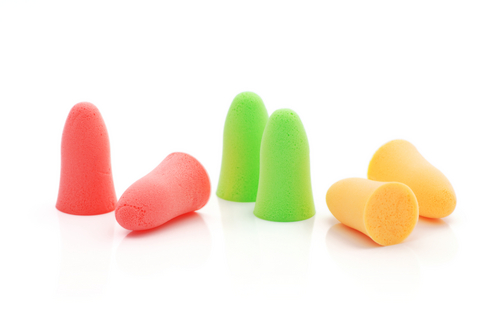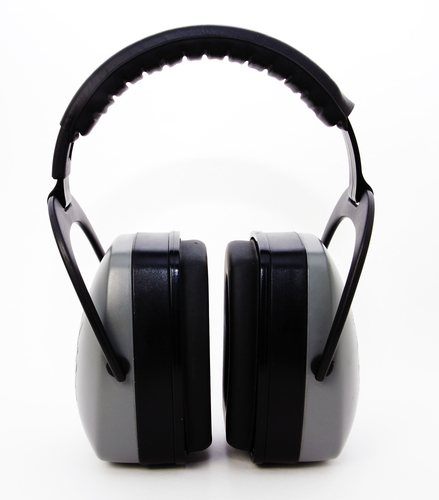Ear Plugs and Hearing Protection
Ear plugs are the most common form of hearing protection. They are generally made from wax, silicone, or memory foam, and can prevent damage that might otherwise be caused to the ear by loud noises or water. Certain types are also used to alleviate pain caused by pressure changes during travel by plane. Acoustic ear muffs are an external alternative to plugs, and are often employed in noisy work environments as hearing protection from industrial noise.
WHAT IS HEARING PROTECTION AND WHY DO I NEED IT?
 Hearing protection is the active defense against potential auditory damage and future hearing impairment, generally with a specific focus on avoiding Noise-Induced Hearing Loss. Preventive measures generally incorporate some type of hearing protector – either plugs or muffs – but on the most basic level protection can involve nothing more than simply limiting one’s exposure to severe or prolonged environmental sounds that are too loud for a healthy human ear. Along with their function in noise reduction, hearing protectors can also serve as primary guards against airborne dust and pathogens, as well as excessive wind, water, and pressure. Everyone can benefit from some amount of auditory protection in certain day-to-day situations, especially those individuals who do regular work in noisy industrial settings, or who are exposed to loud music or overwhelming crowd noise on a regular basis.
Hearing protection is the active defense against potential auditory damage and future hearing impairment, generally with a specific focus on avoiding Noise-Induced Hearing Loss. Preventive measures generally incorporate some type of hearing protector – either plugs or muffs – but on the most basic level protection can involve nothing more than simply limiting one’s exposure to severe or prolonged environmental sounds that are too loud for a healthy human ear. Along with their function in noise reduction, hearing protectors can also serve as primary guards against airborne dust and pathogens, as well as excessive wind, water, and pressure. Everyone can benefit from some amount of auditory protection in certain day-to-day situations, especially those individuals who do regular work in noisy industrial settings, or who are exposed to loud music or overwhelming crowd noise on a regular basis.
WHAT TYPES OF HEARING PROTECTION ARE AVAILABLE AND HOW DO THEY WORK?
Aside from making a habit to avoid violent noise, the two most basic types of auditory protection are ear plugs and ear muffs. Ear plugs are intended to be placed inside the ear or canal, and can be extremely effective in mitigating environmental noise. They can also be used to prevent water from entering the inner-ear during swimming or baths, and can be effective at deterring the buildup of dust and debris. Available in a variety of styles and materials, ear plugs can often be purchased as “one size fits all,” or individually molded for a more personal fit. They are popularly employed for everything from plane flights to rock concerts, and require very little education and instruction before use.
 The alternatives to ear plugs are ear muffs, which are external protective coverings typically worn by airport crews, machine operators, military personnel, and other individuals who spend long hours in extremely loud settings. Muffs are similarly effective at reducing potentially destructive noise levels, but, unlike plugs, they do not enter the ear, providing greater protective coverage to the outer ear bowl with less potential for internal discomfort. Thermal ear muffs are also available, to provide protection from severe weather conditions and extreme exposure, reducing the impact of wind chills and limiting the risk of frostbite and infection.
The alternatives to ear plugs are ear muffs, which are external protective coverings typically worn by airport crews, machine operators, military personnel, and other individuals who spend long hours in extremely loud settings. Muffs are similarly effective at reducing potentially destructive noise levels, but, unlike plugs, they do not enter the ear, providing greater protective coverage to the outer ear bowl with less potential for internal discomfort. Thermal ear muffs are also available, to provide protection from severe weather conditions and extreme exposure, reducing the impact of wind chills and limiting the risk of frostbite and infection.
WHERE CAN I BUY EAR PLUGS AND EAR MUFFS?
Ear plugs of various types and prices are available at a variety of large retailers, audio specialty shops, and even gas stations. Likewise, protective ear muffs can be purchased online, at sport and hunting stores, or from individual dealers. When considering what type of ear protection might be appropriate for your given situation and condition, it is always best to consult your local audiologist, who will be able to determine what shape, material, and style of ear protector will be the least irritating and most effective given your particular case. Call 1-888-HEAR-CLEAR and schedule a consultation with the top audiologist in your area.

